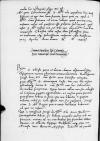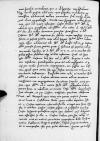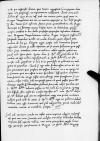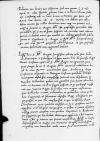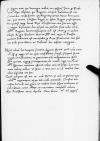Nudius quintus ⌊⌋ ⌊hinc⌋ Dominationi Vestrae Reverendissimae cum ⌊Stanislao Vitreatore⌋, quem magnificus dominus ⌊Hieronymus Laski⌋ ⌊huc⌋ cum litteris miserit pollicebarque latius Dominationi Vestrae Reverendissimae cum ⌊hoc cubiculario⌋ de omnibus scripturum. Cum tamen adhuc non sim admissus ad ⌊caesarem⌋ propter aegritudinem et nescio quem pruritum, quem fertur habere in facie, quo non libenter a quopiam videtur, nihil se tale offert, cur sim prolixior. Scripsi etiam serenissimae ⌊maiestati regiae⌋, quae in novis hactenus habuimus, ad quae me refero.
Quae in ⌊⌋ scripsi de illustrissimo domino ⌊duce Frederico comite palatino Rheni⌋, sic habent et pridie eadem mihi confirmavit, veniens ad me cum duobus suis fratribus ⌊Ottone Henrico⌋ et Alberto episcopo Ratisbonensi atque etiam cum ⌊Ernesto duce Bavariae episcopo Pataviensi⌋ ad prandium,  BJ, 6557, f. 343r in quo eos, licet se ipsos invitaverant, satis laute tractavi. Haec sunt ista convivia, quae mihi serenissima ⌊reginalis maiestas⌋ obicit et quae non regiis neque reginalibus pecuniis, quae ad victum ordinarium mihi numquam suffecerunt, sed quae pro honore ⌊utriusque maiestatis⌋ et ⌊regni⌋ meis impensis hucusque feci et adhuc, quantum convenit, Deo favente, facturus sum et quae aliquando multum rebus reginalis maiestatis profuerunt, licet scribat me nihil aliud praeter verba et nullum commodum procurasse, vel ex litterarum eius ad me exemplo, quod igitur his inclusi, Dominatio Vestra Reverendissima videbit. Ista convivia et favor principum virorum in hac aula una cum sedula mea cura et diligentia, qua mihi non pauci accreverunt cani, effecerunt, quod primum investituram, deinde remotionem et relaxationem sequestri et quod fuit potissimum consensum matrimonii, sine quo ⌊reginalis maiestas⌋ totum feudum in ⌊regno Neapolitano⌋ amiserat, per medium ⌊magni olim Gattinari superinscribed, in the hand of other⌈GattinariGattinari superinscribed, in the hand of other⌉ cancellarii⌋ et aliorum amicorum a ⌊maiestate caesarea⌋ impetraverim.
BJ, 6557, f. 343r in quo eos, licet se ipsos invitaverant, satis laute tractavi. Haec sunt ista convivia, quae mihi serenissima ⌊reginalis maiestas⌋ obicit et quae non regiis neque reginalibus pecuniis, quae ad victum ordinarium mihi numquam suffecerunt, sed quae pro honore ⌊utriusque maiestatis⌋ et ⌊regni⌋ meis impensis hucusque feci et adhuc, quantum convenit, Deo favente, facturus sum et quae aliquando multum rebus reginalis maiestatis profuerunt, licet scribat me nihil aliud praeter verba et nullum commodum procurasse, vel ex litterarum eius ad me exemplo, quod igitur his inclusi, Dominatio Vestra Reverendissima videbit. Ista convivia et favor principum virorum in hac aula una cum sedula mea cura et diligentia, qua mihi non pauci accreverunt cani, effecerunt, quod primum investituram, deinde remotionem et relaxationem sequestri et quod fuit potissimum consensum matrimonii, sine quo ⌊reginalis maiestas⌋ totum feudum in ⌊regno Neapolitano⌋ amiserat, per medium ⌊magni olim Gattinari superinscribed, in the hand of other⌈GattinariGattinari superinscribed, in the hand of other⌉ cancellarii⌋ et aliorum amicorum a ⌊maiestate caesarea⌋ impetraverim.
Qui consensus si non a me fuisset obtentus ante ⌊viceregis⌋ mortui adventum, numquam postea ⌊caesar⌋ illum dedisset, tantum vicerex tum ad ⌊statum Barensem⌋ omnibus modis inhiabat. Et si consensus datus non fuisset, iam pridem ⌊Bario⌋ caruissemus. Crevit ob eum consensum, sic datum, non parvum inter ⌊magnum cancellarium⌋ et ⌊viceregem⌋ odium et aperta simultas, quae etiam rebus ⌊reginalis maiestatis⌋ non obfuit ausimque sancte asserere coram Dominatione Vestra Reverendissima, quod nisi magnus cancellarius a me inductus, cum amicus mihi esset adhuc a tempore ⌊Maximiliani caesaris⌋ singularissimus, partes serenissimae reginalis maiestatis suscepisset, iam dudum de ⌊statu Barensi⌋ actum fuisset. Et cum ⌊vicerex⌋ sciret me tantopere et apud ⌊caesarem⌋, et ⌊magnum cancellarium⌋ pro retinendo ⌊statu Barensi⌋ laborare, primum me promissis quinque milibus ducatis nitebatur abducere, saltem ne ⌊caesarem⌋ adeo molestarem, quod[1] cum Deo gratia praeficere non potuit, curavit cum confessore caesaris, ut inquisitio captis duobus  BJ, 6557, f. 343v meis famulis me turbaret, quo a diligentia mea distraheret. Neque hoc illi profuit, nihil enim, quae expedire videbantur egi remissius, nihilominus nullum commodum, sed verba dumtaxat dicor expedivisse.
BJ, 6557, f. 343v meis famulis me turbaret, quo a diligentia mea distraheret. Neque hoc illi profuit, nihil enim, quae expedire videbantur egi remissius, nihilominus nullum commodum, sed verba dumtaxat dicor expedivisse.
Omitto nunc sexaginta milia ducatorum, quae ad meam instantiam ⌊caesar⌋ donavit ⌊reginali maiestati⌋ de adohis non persolutis ab illustrissima ⌊olim matre⌋ serenissimae ⌊reginalis maiestatis⌋ et duo alia milia ducatorum, quae sine commissione a maiestate caesarea reginali maiestati impetravi de adohis nuper impositis. De ⌊Monte Serico⌋ et pascuis parum, immo nihil, ferunt ⌊reginalem maiestatem⌋ habere iuris, effeci nihilominus, ubi reginali maiestati deesset iustitia, quod ⌊caesarea maiestas⌋ promisit facere gratiam, quam si facturus est, experiar, nullum non movebo lapidem[2], ut serenissimae reginali maiestati ea in re et in omnibus aliis, quibus possum, fideliter atque utiliter inserviam. Quod, ut spero, ipsa ⌊maiestas caesarea⌋ litteris suis ad serenissimam ⌊maiestatem regiam⌋ in reditu meo testabitur, quandoquidem, cum tot mihi neglegentiae et quod nisi per verba servierim, impinguntur, non possum non caesarem, apud quem omnia ista egi, testem vocare, nec mihi verum eius deerit testimonium.
Praescribit etiam mihi et mandat ⌊reginalis maiestas⌋, ut omnino a ⌊caesare⌋ obtineam novem milium ducatorum remissionem cum nongingentorum ducatorum singulis annis pensione, quae illustrissima ⌊olim mater⌋ reginalis maiestatis quibusdam debuit, quorum bona in rebellione et crimine laesae maiestatis deprehensis sunt adempta et pro caesare confiscata, praeterea adohanam ⌊Trani⌋ vel ⌊Monopoli⌋, quae etiam non parvam conficit summam, et ut liceat ei castellanum Barensem, quem vellet, deputare. Ista ut a ⌊caesare⌋ impetrem, adeo mihi stricte iniungit, non secus atque ista vi quadam caesari eripere possem, et expostulat mecum, quod caesar Hispanis quibusdam nescio quae dederit, et si diligentia mea affuisset, se illa a caesare habere potuisse vultque, ut merita ⌊eius⌋ et ⌊matris⌋, praeterea expensas in bello novissimo contra ⌊Gallorum regem⌋ profusas caesari saepius inculcem et in recompensam ista, quae petit, obtineam, ignara, quae aliquando  BJ, 6557, f. 344r mihi pro responsis dantur, quae tamen cognoscens hunc sexum data opera non perscripsi, ne impatientior redderetur. Paulo ante mihi dictum est: „Qua de re, inquam, ⌊domina tua⌋ tantum petit, quasi nemo in ⌊regno Neapolitano⌋ non tot et maiores expensas in hoc bello fecisset quam illa. Nonne fuit astricta ⌊statum suum⌋, quemadmodum alii ⌊regni⌋ principes et barones contra hostes tueri et defendere, quod si ⌊caesar⌋ omnibus in hoc bello profusas expensas refundere deberet, non ⌊regnum Neapolitanum⌋, nedum regna Hispaniae sufficerent”. Istiusmodi interdum verba et multo duriora, cum aliquid peto, audire ab his, qui dirigunt, cogor. ⌊Caesar⌋ mihi humaniter semper respondet, dicens se velle informari et se omnia facturum, quae possibilia sunt, interdum etiam et meliora addit verba, quibus non semel mihi spem fecit.
BJ, 6557, f. 344r mihi pro responsis dantur, quae tamen cognoscens hunc sexum data opera non perscripsi, ne impatientior redderetur. Paulo ante mihi dictum est: „Qua de re, inquam, ⌊domina tua⌋ tantum petit, quasi nemo in ⌊regno Neapolitano⌋ non tot et maiores expensas in hoc bello fecisset quam illa. Nonne fuit astricta ⌊statum suum⌋, quemadmodum alii ⌊regni⌋ principes et barones contra hostes tueri et defendere, quod si ⌊caesar⌋ omnibus in hoc bello profusas expensas refundere deberet, non ⌊regnum Neapolitanum⌋, nedum regna Hispaniae sufficerent”. Istiusmodi interdum verba et multo duriora, cum aliquid peto, audire ab his, qui dirigunt, cogor. ⌊Caesar⌋ mihi humaniter semper respondet, dicens se velle informari et se omnia facturum, quae possibilia sunt, interdum etiam et meliora addit verba, quibus non semel mihi spem fecit.
Quam dum serenissimae ⌊reginali maiestati⌋ perscribo et his verbis ut ipse audivi, rescribit mihi serenissima reginalis maiestas: „Tu, ut ista et ista mihi expedires, in litteris Tuis promisisti et pollicitus es, volo igitur, ut expedias”. Quod si ego adeo stultus essem, ut ea de ⌊caesare⌋ promitterem, quae praestare non possem, deberet ne a me exigi, ut ea facerem, quae non essent in mea facultate? Iussi quidem aliquoties bene sperare, ita ut ego iussus eram pleraque etiam successerunt, si non omnia, culpa tribui mihi non potest, cum id, quod possim facio et deinceps oppido quam libentissime facturus sum, modo adsit facultas, qua serenissimam ⌊reginalem maiestatem⌋ inducere possim, ne tam male de me sentiat igiturque tam diffuse ista iustis de causis impulsus Dominationi Vestrae Reverendissimae descripsi, ut habeat, quid pro me respondeat meque cum primis certiorem reddat, quid mihi de animo serenissimae reginalis maiestatis erga me polliceri debeam. Nollem enim esse ⌊Levicius⌋ vel sub indignatione quovis modo illam convenire,
cf. Verg. A. IV 569-570 varium et mutabile semper femina ⌊varium et mutabile sempercf. Verg. A. IV 569-570 varium et mutabile semper femina ⌋ etc.
Sed ad convivia, unde me iustus animi impetus abegit, redeundum est, quae non cum scurris aut occlusus cum nihili hominibus habere consuevi, sed apertis valvis cum viris principibus, unde honor atque excelsa existimatio serenissimae ⌊regiae et reginalis maiestatis⌋ regnique  BJ, 6557, f. 344v ⌊Poloniae⌋ non levior aut obscurior, sed non parum (si mihi apud Dominationem Vestram Reverendissimam gloriari licet) auctior et clarior facta est constantque mihi in hanc horam a tempore, quo exivi 1524-03-15⌊XV-a Martii anni Domini MDXXIIII1524-03-15⌋, cum debitis, quae adhuc debeo circiter sex milia ducatorum auri neque me paenitet vel umquam in servitio serenissimae ⌊regiae maiestatis⌋ ista profudisse paenitebit. Dominus providebit, qui si me, ut spero, sospitem ad oviculas meas reducere faciet, in duobus annis ex omnibus me debitis explicabo, fidelis servus et capellanus serenissimae ⌊regiae et reginalis maiestatis⌋ semper futurus et Dominationi Vestrae Reverendissimae perpetuo addictissimus, a qua post Deum initium felicitatis meae augmentum habuit.
BJ, 6557, f. 344v ⌊Poloniae⌋ non levior aut obscurior, sed non parum (si mihi apud Dominationem Vestram Reverendissimam gloriari licet) auctior et clarior facta est constantque mihi in hanc horam a tempore, quo exivi 1524-03-15⌊XV-a Martii anni Domini MDXXIIII1524-03-15⌋, cum debitis, quae adhuc debeo circiter sex milia ducatorum auri neque me paenitet vel umquam in servitio serenissimae ⌊regiae maiestatis⌋ ista profudisse paenitebit. Dominus providebit, qui si me, ut spero, sospitem ad oviculas meas reducere faciet, in duobus annis ex omnibus me debitis explicabo, fidelis servus et capellanus serenissimae ⌊regiae et reginalis maiestatis⌋ semper futurus et Dominationi Vestrae Reverendissimae perpetuo addictissimus, a qua post Deum initium felicitatis meae augmentum habuit.
Postquam heri serenissimae ⌊maiestati regiae⌋ scripsissem, allatae mihi sunt hodie ab ⌊Antverpia⌋ a fidedigno et bono amico litterae de successu ⌊regis Daniae Cristierni⌋, quem ut serenissima maiestas regia non ignoraret, cum prius semper de eo serenissimam regiam maiestatem certiorem reddiderim, his ad Dominationem Vestram Reverendissimam annotandum duxi. Scribiturque ⌊rex Cristiernus⌋ aliquamdiu in ⌊Norvegia⌋ castrum quoddam Babusen nuncupatum obsedisset accepissetque secum ad eam obsidionem ex navibus Hollandinis, quibus cum gentibus suis fuerat advectus, vela et temones, ne ab eo fugere possent et quod paulo post ⌊Gustavus⌋, qui ⌊Sweciae⌋ regem se scribit, cum magna rusticorum, quos Dalkerles vocant, multitudine et quibusdam etiam peditibus Germanis, ut subveniret obsessis, regi Christierno propinquasset et cum illo conflixisset, in quo conflictu rex Christiernus 900 pedites amisisset et se in quasdam montium angustias cum reliquiis retraxisset, in quibus a ⌊Suetis⌋ obsidetur misitque parvam scapham cum quodam capitaneo in ⌊Brabantiam⌋ pro suppetiis, qui his diebus ⌊Antverpiae⌋ applicuit, nihil impetraturus et quod interea, quo fuerat conflictus, obsessi a castro descendissent et castra cum tentoriis regis Christierni superinscribed, in the hand of other⌈ChristierniChristierni superinscribed, in the hand of other⌉ incendissent, in quibus cum temonibus vela omnia sunt concremata, unde  BJ, 6557, f. 345r si fugere mari ex ⌊Norvegia⌋ vellet, non posset. Item quod ⌊Fredericus dux Olsatiae⌋, qui ⌊regnum⌋ occupat, habiturus est cum civitatibus confoederatis quadraginta quattuor naves bene armatas, quae contra classem ⌊regis⌋ et ipsum regem proficiscuntur. Non potest itaque bonus ⌊rex Christiernus⌋ cum suis non esse in magno discrimine. Haec ut ad me perlata sunt, nolui, ut serenissimam ⌊maiestatem regiam⌋ laterent.
BJ, 6557, f. 345r si fugere mari ex ⌊Norvegia⌋ vellet, non posset. Item quod ⌊Fredericus dux Olsatiae⌋, qui ⌊regnum⌋ occupat, habiturus est cum civitatibus confoederatis quadraginta quattuor naves bene armatas, quae contra classem ⌊regis⌋ et ipsum regem proficiscuntur. Non potest itaque bonus ⌊rex Christiernus⌋ cum suis non esse in magno discrimine. Haec ut ad me perlata sunt, nolui, ut serenissimam ⌊maiestatem regiam⌋ laterent.
Scriptum mihi est etiam, quod in eadem classe ⌊regis Frederici Daniae⌋ illustris dominus ⌊dux in Prussia⌋ quattuor habiturus est naves et quod rex Fredericus cum suis non vult permittere, ut ⌊Hollandi⌋ hac aestate navigent.
Nihil aliud hoc tempore scientia dignum Reverendissimae Dominationis Vestrae occurrit, quam quod rogo, ut ea, quae confidenter scripsi, sic apud se contineat et moderetur, ne graviorem mihi indignationem ⌊reginalis maiestatis⌋ pariant rogoque summopere me de mente erga me illius maiestatis quam primum certiorem efficiat, nollem enim, ⌊⌋, Leviciano more redire. Adhuc, ut spero, a Deo meo et ab omnibus hominibus desertus non sum.
Quod reliquum est, me Dominationi Vestrae Reverendissimae, ut domino et patrono meo colendissimo maximopere et ex toto corde commendo. Christus, Dominus noster, det mihi eam gratiam, ut eandem brevi sospes incolumem et felicissimam coram alloqui et reverenter complecti valeam.
 BJ, 6557, f. 342v
BJ, 6557, f. 342v
 BJ, 6557, f. 343r in quo eos, licet se ipsos invitaverant, satis laute tractavi. Haec sunt ista convivia, quae mihi serenissima
BJ, 6557, f. 343r in quo eos, licet se ipsos invitaverant, satis laute tractavi. Haec sunt ista convivia, quae mihi serenissima  BJ, 6557, f. 343v meis famulis me turbaret, quo a diligentia mea distraheret. Neque hoc illi profuit, nihil enim, quae expedire videbantur egi remissius, nihilominus nullum commodum, sed verba dumtaxat dicor expedivisse.
BJ, 6557, f. 343v meis famulis me turbaret, quo a diligentia mea distraheret. Neque hoc illi profuit, nihil enim, quae expedire videbantur egi remissius, nihilominus nullum commodum, sed verba dumtaxat dicor expedivisse.
 BJ, 6557, f. 344r mihi pro responsis dantur, quae tamen cognoscens hunc sexum data opera non perscripsi, ne impatientior redderetur. Paulo ante mihi dictum est: „Qua de re, inquam,
BJ, 6557, f. 344r mihi pro responsis dantur, quae tamen cognoscens hunc sexum data opera non perscripsi, ne impatientior redderetur. Paulo ante mihi dictum est: „Qua de re, inquam,  BJ, 6557, f. 344v
BJ, 6557, f. 344v  BJ, 6557, f. 345r si fugere mari ex
BJ, 6557, f. 345r si fugere mari ex 